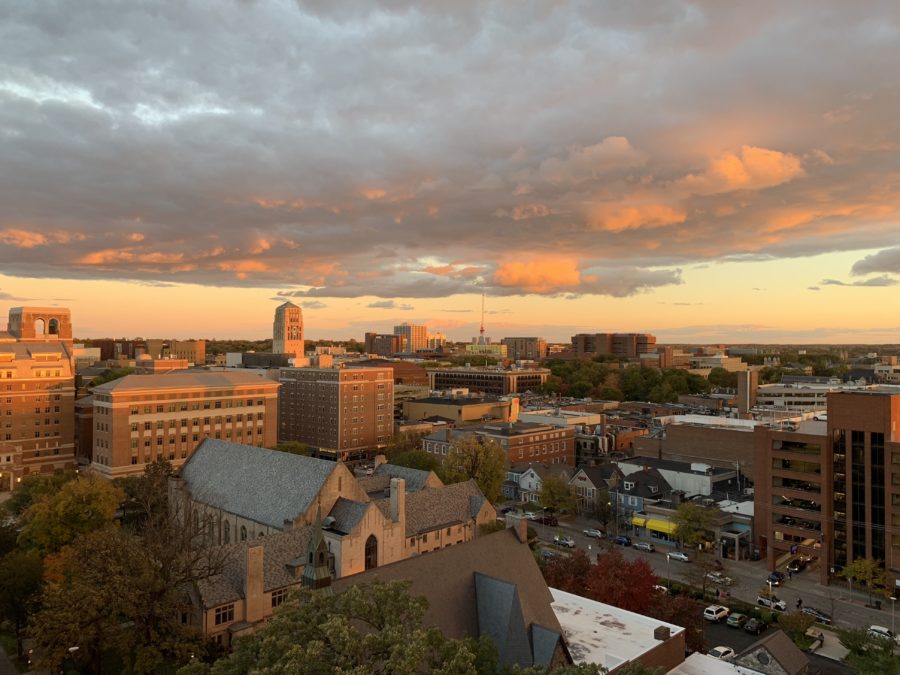Mayor Taylor Discusses Progress on The A2Zero Plan
The A2 Zero plan was passed in 2020. How has Ann Arbor changed since then? What are the issues that have arisen while trying to implement this plan? Are we any closer to carbon neutrality in Ann Arbor? We asked Mayor Christopher Taylor about the progress that has been made so far, and how we can expect our city to change in the coming years.
Do you think that sustainability should be a priority in Ann Arbor?
I absolutely do. And, indeed it is. We passed the city’s A2ZERO plan and adopted it as a formal city document [which] includes a goal of achieving community-wide carbon neutrality by 2030.
So what are the steps in achieving the goals laid out in the A2ZERO plan?
It will require work. The A2ZERO plan has a number of different points of entry to get us to community-wide carbon neutrality, such as reducing vehicle miles by half, moving us closer towards a circular waste economy, [and] working with legislators to reduce the amount of energy and carbon footprint for buildings in our built environment. And of course, working to decarbonize the electrical grid and reduce reliance on gas appliances. We as a city have the ability to take action in a variety of areas. On the electric side, we [would] love to expand solar. We support people putting solar [panels] on their roofs through our solarized program, which creates group buys for residents. We can band together and work with electric solar providers to put solar on the roof and batteries in the basement. Working with the Department of Energy and Scio Township, DTE put a 20-megawatt solar array on the city’s landfill[s] and other mechanisms like that as well.
What are the biggest challenges that you have come across while trying to put this plan into action?
It depends on how far back you want to go. We didn’t have people or money — the staff to do the work or money to support programs that staff can implement. So one of my main tasks was to find resources. I was instrumental in allocating millage (property tax) monies that we receive from the county — about a million dollars a year starting in 2017 go towards the city’s climate action that enabled us to get our staff and programming [in] place and ultimately even come up with the A2ZERO plan. [And] internally, of course, making sure that that was a municipal value issue.
Does this sustainability plan include increasing the number of bike lanes around the city?
Absolutely. Reducing vehicle miles is an important part of accomplishing our A2ZERO goals. We want to make sure that we have the infrastructure available for people to get around with mass transit and without a car. So, the proliferation of protected bike lanes is central to that component of the plan. So let’s talk a little bit about funding. Starting in 2017 or 2018, we were able to get about a million dollars a year which was excellent, but it’s nowhere near what we need. One of the things that I was able to work on after we passed A2ZERO was to put the community climate action millage on the ballot and work hard to get it passed. I’m happy that we were able to accomplish both of those goals. And so now, over the next 20 years, we’ll [be] starting off with about 036;7 million a year and that’ll increase over time with inflation and property values and so forth. So, [it will be] somewhere in the 036;160-170 million range, that the city will fund for climate action going forward.
How are you tracking progress on this plan?
We don’t really have annual goals because so much of the work is multivariable and opportunistic. The plan is designed to iterate, so we tend to have longer-term goals [because] we want to see how we’re doing and generally [how] greenhouse gas emissions track over time. We did have a 20% decrease at our most recent calculation. But over time, we’re going to need to continue to track that as it goes.
How does Ann Arbor compare to other cities in Michigan?
[While] I strongly suspect that many cities and other jurisdictions in the state have a Climate Action Plan or some kind of municipal carbon target, we are unique in that we have a dedicated funding source. Having the target is immaterial if you don’t have the money to get there, [as well as] the resources, and the staff members to run the programs. And, the city passing its climate action millage this past November with 71% of the vote was a really big deal. It puts Ann Arbor on the front foot throughout the state and certainly the country with respect to the work that we’re going to be able to do on climate change.
How can high schoolers in our city make a valuable impact?
There are a couple of things. First, the whole A2ZERO plan requires municipal action, but it really requires action by everyone. It requires education throughout the city. We have A2ZERO ambassadors who are community members who come to City Hall or come to the Zoom once a week and learn about the various components of the A2ZERO plan and how it works. Then, they proliferate that knowledge to their various networks. We do have youth ambassadors that are engaged in that. There are also youth members on the energy commission, the environmental commission and the Transportation Commission in particular. Finally, and most importantly, there are other legislative activities that are necessary in order for us to achieve our goal.
One major issue that I haven’t touched upon yet is land use. Right now, we have about 80,000 people come in and out of Ann Arbor every day to commute and that has major climate impacts. Not every one of those 80,000 people want to live in Ann Arbor, but a lot do and we have a housing crisis. We don’t have enough housing for the people who want to live here [and the] supply and demand is real — we have an affordability problem and that creates economic segregation and that creates racial segregation. One thing that I’ve been focused on, and many of my city council colleagues too, is expanding housing choices in Ann Arbor. We want, of course, to build affordable housing and we are doing that. But we also have to permit property owners to build dense residential housing where we can and that’s not always super popular, so that’s a hard thing to do. So I think what high school students can do is they can make sure that when contentious issues come before city council, or when municipal elections roll around, that they focus in [on] and communicate to city council that this is something that young people are interested in. They understand that that’s not how we want things to be. I guess the bottom line is political participation, working to communicate to the city council, communicating to other members of the community and working on campaigns and hopefully help[ing] create a political culture that is welcoming to all and focused on these important issues.











